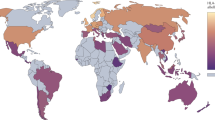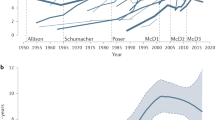Key Points
-
MS has been a treatable disease for approximately 20 years, and incremental improvements in treatment options have culminated in remarkable progress for the amelioration of inflammatory aspects of MS
-
Traditionally, three patterns of disease evolution (relapsing–remitting, secondary progressive and primary progressive) were recognized, but present evidence suggests that these differing clinical phenotypes share common pathophysiology
-
A major unmet medical need in MS therapeutics is to define biomarkers to aid selection from the several treatment options so that individual patients can receive optimal personalized therapy
-
The requirement that patients fail IFN-β and glatiramer acetate therapy before being offered alternatives risks irreversible neural tissue injury during the process of initiating appropriate medication
-
Early, general statements that implicated a genetic component in multiple sclerosis (MS) susceptibility have been replaced by the identification of more than 100 genetic variants associated with disease susceptibility, ∼90% of which are noncoding
-
Over half of genetic variants associated with MS risk are also found in other autoimmune diseases, and are primarily associated with genes that regulate immune function
Abstract
Multiple sclerosis (MS) has been thought to be a complex and indecipherable disease, and poorly understood with regards to aetiology. Here, we suggest an emphatically positive view of progress over several decades in the understanding and treatment of MS, particularly focusing on advances made within the past 20 years. As with virtually all complex disorders, MS is caused by the interaction of genetic and environmental factors. In recent years, formidable biochemical, bioinformatic, epidemiological and neuroimaging tools have been brought to bear on research into the causes of MS. While susceptibility to the disease is now relatively well accounted for, disease course is not and remains a salient challenge. In the therapeutic realm, numerous agents have become available, reflecting the fact that the disease can be attacked successfully at many levels and using varied strategies. Tailoring therapies to individuals, risk mitigation and selection of first-line as compared with second-line medications remain to be completed. In our view, the MS landscape has been comprehensively and irreversibly transformed by this progress. Here we focus on MS therapeutics—the most meaningful outcome of research efforts.
This is a preview of subscription content, access via your institution
Access options
Subscribe to this journal
Receive 12 print issues and online access
$209.00 per year
only $17.42 per issue
Buy this article
- Purchase on SpringerLink
- Instant access to full article PDF
Prices may be subject to local taxes which are calculated during checkout

Similar content being viewed by others
Change history
24 March 2015
In the version of this article initially published online, the Competing interests section was incomplete. The error has been corrected for the PDF and HTML versions of the article.
19 February 2015
In the version of this article initially published online, the Acknowledgements section was incomplete. The error has been corrected for the print, PDF and HTML versions of the article.
References
Charcot, J. M. Histologie de la sclérose en plaques [French]. Gazette des Hopitaux 41, 554–555 (1868).
Dawson, J. D. The histology of disseminated sclerosis. Trans. Royal Soc. Edin. 50, 517–740 (1916).
Fishman, R. A. Cerebrospinal fluid in diseases of the nervous system. 2nd edn (W. B. Saunders, 1992).
Rivers, T. M., Sprunt, D. H. & Berry, G. P. Observations on attempts to produce acute disseminated encephalomyelitis in monkeys. J. Exp. Med. 58, 39–56 (1933).
Compston, A. & Sadovnick, A. D. Epidemiology and genetics of multiple sclerosis. Curr. Opin. Neurol. Neurosurg. 5, 175–181 (1992).
Rudick, R. A., Goodkin, D. E. & Ransohoff, R. M. Pharmacotherapy of multiple sclerosis: current status. Cleve. Clin. J. Med. 59, 267–277 (1992).
Weinshenker, B. G. The natural history of multiple sclerosis. Neurol. Clin. 13, 119–146 (1995).
Okuda, D. T. et al. Asymptomatic spinal cord lesions predict disease progression in radiologically isolated syndrome. Neurology 76, 686–692 (2011).
Amato, M. P. et al. Association of MRI metrics and cognitive impairment in radiologically isolated syndromes. Neurology 78, 309–314 (2012).
Okuda, D. T. et al. Radiologically isolated syndrome: 5-year risk for an initial clinical event. PloS ONE 9, e90509 (2014).
Calabrese, M. et al. Low degree of cortical pathology is associated with benign course of multiple sclerosis. Mult. Scler. 19, 904–911 (2013).
Correale, J., Ysrraelit, M. C. & Fiol, M. P. Benign multiple sclerosis: does it exist? Curr. Neurol. Neurosci. Rep. 12, 601–609 (2012).
Calabrese, M. et al. Evidence for relative cortical sparing in benign multiple sclerosis: a longitudinal magnetic resonance imaging study. Mult. Scler. 15, 36–41 (2009).
Portaccio, E. et al. Neuropsychological and MRI measures predict short-term evolution in benign multiple sclerosis. Neurology 73, 498–503 (2009).
Benedict, R. H. & Fazekas, F. Benign or not benign MS: a role for routine neuropsychological assessment? Neurology 73, 494–495 (2009).
Hawkins, S. A. & McDonnell, G. V. Benign multiple sclerosis? Clinical course, long term follow up, and assessment of prognostic factors. J. Neurol. Neurosurg. Psychiatry 67, 148–152 (1999).
Stern, J. N. et al. B cells populating the multiple sclerosis brain mature in the draining cervical lymph nodes. Sci. Transl. Med. 6, 248ra107 (2014).
[No authors listed] Interferon beta-1b is effective in relapsing-remitting multiple sclerosis. I. Clinical results of a multicenter, randomized, double-blind, placebo-controlled trial. The IFNB Multiple Sclerosis Study Group. Neurology 43, 655–661 (1993).
Hauser, S. L. et al. Intensive immunosuppression in progressive multiple sclerosis—a randomized, three-arm study of high-dose intravenous cyclophosphamide, plasma exchange, and ACTH. N. Engl. J. Med. 308, 173–180 (1983).
Paty, D. W. & Li, D. K. Interferon beta-1b is effective in relapsing-remitting multiple sclerosis. II. MRI analysis results of a multicenter, randomized, double-blind, placebo-controlled trial. UBC MS/MRI Study Group and the IFNB Multiple Sclerosis Study Group. Neurology 43, 662–667 (1993).
McGraw, C. A. & Lublin, F. D. Interferon beta and glatiramer acetate therapy. Neurotherapeutics 10, 2–18 (2013).
Trojano, M. et al. Real-life impact of early interferonβ therapy in relapsing multiple sclerosis. Ann. Neurol. 66, 513–520 (2009).
Trojano, M. et al. New natural history of interferon-β-treated relapsing multiple sclerosis. Ann. Neurol. 61, 300–306 (2007).
Scalfari, A. et al. Mortality in patients with multiple sclerosis. Neurology 81, 184–192 (2013).
Goodin, D. S. et al. Survival in MS: a randomized cohort study 21 years after the start of the pivotal IFNβ-1b trial. Neurology 78, 1315–1322 (2012).
Bermel, R. A. et al. Predictors of long-term outcome in multiple sclerosis patients treated with interferon β. Ann. Neurol. 73, 95–103 (2013).
Prosperini, L. et al. Interferon beta failure predicted by EMA criteria or isolated MRI activity in multiple sclerosis. Mult. Scler. 20, 566–576 (2014).
Borden, E. C. et al. Interferons at age 50: past, current and future impact on biomedicine. Nat. Rev. Drug Discov. 6, 975–990 (2007).
Comabella, M. et al. A type I interferon signature in monocytes is associated with poor response to interferon-β in multiple sclerosis. Brain 132, 3353–3365 (2009).
Ottoboni, L. et al. An RNA profile identifies two subsets of multiple sclerosis patients differing in disease activity. Sci. Transl. Med. 4, 153ra131 (2012).
Cohen, J. A. et al. Oral fingolimod or intramuscular interferon for relapsing multiple sclerosis. N. Engl. J. Med. 362, 402–415 (2010).
Kappos, L. et al. A placebo-controlled trial of oral fingolimod in relapsing multiple sclerosis. N. Engl. J. Med. 362, 387–401 (2010).
Kappos, L. et al. Oral fingolimod (FTY720) for relapsing multiple sclerosis. N. Engl. J. Med. 355, 1124–1140 (2006).
Brown, B. A. Natalizumab in the treatment of multiple sclerosis. Ther. Clin. Risk Manag. 5, 585–594 (2009).
Ransohoff, R. M. Natalizumab for multiple sclerosis. N. Engl. J Med. 356, 2622–2629 (2007).
Yednock, T. A. et al. Prevention of experimental autoimmune encephalomyelitis by antibodies against α4β1 integrin. Nature 356, 63–66 (1992).
Rudick, R. A. et al. Natalizumab plus interferon beta-1a for relapsing multiple sclerosis. N. Engl. J. Med. 354, 911–923 (2006).
Polman, C. H. et al. A randomized, placebo-controlled trial of natalizumab for relapsing multiple sclerosis. N. Engl. J. Med. 354, 899–910 (2006).
Langer-Gould, A., Atlas, S. W., Green, A. J., Bollen, A. W. & Pelletier, D. Progressive multifocal leukoencephalopathy in a patient treated with natalizumab. N. Engl. J. Med. 353, 375–381 (2005).
Koralnik, I. J. Progressive multifocal leukoencephalopathy revisited: has the disease outgrown its name? Ann. Neurol. 60, 162–173 (2006).
Yousry, T. A. et al. Evaluation of patients treated with natalizumab for progressive multifocal leukoencephalopathy. N. Engl. J. Med. 354, 924–933 (2006).
Ransohoff, R. M. PML risk and natalizumab: more questions than answers. Lancet Neurol. 9, 231–233 (2010).
Bloomgren, G. et al. Risk of natalizumab-associated progressive multifocal leukoencephalopathy. N. Engl. J. Med. 366, 1870–1880 (2012).
Pelletier, D. & Hafler, D. A. Fingolimod for multiple sclerosis. N. Engl. J. Med. 366, 339–347 (2012).
Hu, Y. et al. Sphingosine 1-phosphate receptor modulator fingolimod (FTY720) does not promote remyelination in vivo. Mol. Cell. Neurosci. 48, 72–81 (2011).
Jung, C. G. et al. Functional consequences of S1P receptor modulation in rat oligodendroglial lineage cells. Glia 55, 1656–1667 (2007).
Stecchi, S., Scandellari, C., Gabrielli, L. & Lazzarotto, T. Recommendations for fingolimod treated patients vacinated for varicella zoster virus. Neurology 82 (Suppl.), P7.217 (2014).
Gold, R. et al. Placebo-controlled phase 3 study of oral BG-12 for relapsing multiple sclerosis. N. Engl. J. Med. 367, 1098–1107 (2012).
Fox, R. J. et al. Placebo-controlled phase 3 study of oral BG-12 or glatiramer in multiple sclerosis. N. Engl. J. Med. 367, 1087–1097 (2012).
Kappos, L. et al. Effect of BG-12 on contrast-enhanced lesions in patients with relapsing–remitting multiple sclerosis: subgroup analyses from the phase 2b study. Mult. Scler. 18, 314–321 (2012).
Kappos, L. et al. Efficacy and safety of oral fumarate in patients with relapsing–remitting multiple sclerosis: a multicentre, randomised, double-blind, placebo-controlled phase IIb study. Lancet 372, 1463–1472 (2008).
Cohen, J. A. et al. Alemtuzumab versus interferon beta 1a as first-line treatment for patients with relapsing–remitting multiple sclerosis: a randomised controlled phase 3 trial. Lancet 380, 1819–1828 (2012).
Coles, A. J. et al. Alemtuzumab for patients with relapsing multiple sclerosis after disease-modifying therapy: a randomised controlled phase 3 trial. Lancet 380, 1829–1839 (2012).
CAMMS223 Trial Investigators et al. Alemtuzumab vs. interferon beta-1a in early multiple sclerosis. N. Engl. J. Med. 359, 1786–1801 (2008).
Comi, G. et al. Placebo-controlled trial of oral laquinimod for multiple sclerosis. N. Engl. J. Med. 366, 1000–1009 (2012).
Comi, G. et al. Effect of laquinimod on MRI-monitored disease activity in patients with relapsing–remitting multiple sclerosis: a multicentre, randomised, double-blind, placebo-controlled phase IIb study. Lancet 371, 2085–2092 (2008).
Gold, R. et al. Daclizumab high-yield process in relapsing–remitting multiple sclerosis (SELECT): a randomised, double-blind, placebo-controlled trial. Lancet 381, 2167–2175 (2013).
Wynn, D. et al. Daclizumab in active relapsing multiple sclerosis (CHOICE study): a phase 2, randomised, double-blind, placebo-controlled, add-on trial with interferon beta. Lancet Neurol. 9, 381–390 (2010).
Bielekova, B. et al. Humanized anti-CD25 (daclizumab) inhibits disease activity in multiple sclerosis patients failing to respond to interferon β. Proc. Natl Acad. Sci. USA 101, 8705–8708 (2004).
Farh, K. K. et al. Genetic and epigenetic fine mapping of causal autoimmune disease variants. Nature http://dx.doi.org/10.1038/nature13835.
Wiendl, H. & Hohlfeld, R. Therapeutic approaches in multiple sclerosis: lessons from failed and interrupted treatment trials. BioDrugs 16, 183–200 (2002).
Panitch, H. S., Hirsch, R. L., Haley, A. S. & Johnson, K. P. Exacerbations of multiple sclerosis in patients treated with gamma interferon. Lancet 1, 893–895 (1987).
Panitch, H. S., Hirsch, R. L., Schindler, J. & Johnson, K. P. Treatment of multiple sclerosis with gamma interferon: exacerbations associated with activation of the immune system. Neurology 37, 1097–1102 (1987).
Glabinski, A. R., Krakowski, M., Han, Y., Owens, T. & Ransohoff, R. M. Chemokine expression in GKO mice (lacking interferon-gamma) with experimental autoimmune encephalomyelitis. J. Neurovirol. 5, 95–101 (1999).
Krakowski, M. & Owens, T. Interferon-γ confers resistance to experimental allergic encephalomyelitis. Eur. J. Immunol. 26, 1641–1646 (1996).
van Oosten, B. W. et al. Increased MRI activity and immune activation in two multiple sclerosis patients treated with the monoclonal anti-tumor necrosis factor antibody cA2. Neurology 47, 1531–1534 (1996).
[No authors listed] TNF neutralization in MS: results of a randomized, placebo-controlled multicenter study. The Lenercept Multiple Sclerosis Study Group and The University of British Columbia MS/MRI Analysis Group. Neurology 53, 457–465 (1999).
Solomon, A. J., Spain, R. I., Kruer, M. C. & Bourdette, D. Inflammatory neurological disease in patients treated with tumor necrosis factor alpha inhibitors. Mult. Scler. 17, 1472–1487 (2011).
Ottoboni, L. et al. Clinical relevance and functional consequences of the TNFRSF1A multiple sclerosis locus. Neurology 81, 1891–1899 (2013).
Dendrou, C. A., Bell, J. I. & Fugger, L. A clinical conundrum: the detrimental effect of TNF antagonists in multiple sclerosis. Pharmacogenomics 14, 1397–1404 (2013).
Chen, X. & Oppenheim, J. J. Contrasting effects of TNF and anti-TNF on the activation of effector T cells and regulatory T cells in autoimmunity. FEBS Lett. 585, 3611–3618 (2011).
Cua, D. J. et al. Interleukin-23 rather than interleukin-12 is the critical cytokine for autoimmune inflammation of the brain. Nature 421, 744–748 (2003).
Ivanov, I. I. et al. The orphan nuclear receptor RORγt directs the differentiation program of proinflammatory IL-17+ T helper cells. Cell 126, 1121–1133 (2006).
Segal, B. M. et al. Repeated subcutaneous injections of IL12/23 p40 neutralising antibody, ustekinumab, in patients with relapsing–remitting multiple sclerosis: a phase II, double-blind, placebo-controlled, randomised, dose-ranging study. Lancet Neurol. 7, 796–804 (2008).
Ryan, C., Thrash, B., Warren, R. B. & Menter, A. The use of ustekinumab in autoimmune disease. Expert Opin. Biol. Ther. 10, 587–604 (2010).
Kappos, L. et al. Ocrelizumab in relapsing-remitting multiple sclerosis: a phase 2, randomised, placebo-controlled, multicentre trial. Lancet 378, 1779–1787 (2011).
Ransohoff, R. M. A mighty mouse: building a better model of multiple sclerosis. J. Clin. Invest. 116, 2313–2316 (2006).
Lulu, S. & Waubant, E. Humoral-targeted immunotherapies in multiple sclerosis. Neurotherapeutics 10, 34–43 (2013).
Meinl, E., Derfuss, T., Krumbholz, M., Probstel, A. K. & Hohlfeld, R. Humoral autoimmunity in multiple sclerosis. J. Neurol. Sci. 306, 180–182 (2011).
Beck, R. W. et al. A randomized, controlled trial of corticosteroids in the treatment of acute optic neuritis. The Optic Neuritis Study Group. N. Engl. J. Med. 326, 581–588 (1992).
Major, E. O., Frohman, E. & Douek, D. JC viremia in natalizumab-treated patients with multiple sclerosis. N. Engl. J. Med. 368, 2240–2241 (2013).
International Multiple Sclerosis Genetics Consortium (IMSGC) et al. Analysis of immune-related loci identifies 48 new susceptibility variants for multiple sclerosis. Nat. Genet. 45, 1353–1360 (2013).
Hafler, D. A. et al. Risk alleles for multiple sclerosis identified by a genomewide study. N. Engl. J. Med. 357, 851–862 (2007).
Cotsapas, C. & Hafler, D. A. Immune-mediated disease genetics: the shared basis of pathogenesis. Trends Immunol. 34, 22–26 (2013).
Frischer, J. M. et al. The relation between inflammation and neurodegeneration in multiple sclerosis brains. Brain 132, 1175–1189 (2009).
Hochmeister, S. et al. Dysferlin is a new marker for leaky brain blood vessels in multiple sclerosis. J. Neuropathol. Exp. Neurol. 65, 855–865 (2006).
Howell, O. W. et al. Meningeal inflammation is widespread and linked to cortical pathology in multiple sclerosis. Brain 134, 2755–2771 (2011).
Magliozzi, R. et al. A gradient of neuronal loss and meningeal inflammation in multiple sclerosis. Ann. Neurol. 68, 477–493 (2010).
Serafini, B., Rosicarelli, B., Magliozzi, R., Stigliano, E. & Aloisi, F. Detection of ectopic B-cell follicles with germinal centers in the meninges of patients with secondary progressive multiple sclerosis. Brain Pathol. 14, 164–174 (2004).
Popescu, B. F., Bunyan, R. F., Parisi, J. E., Ransohoff, R. M. & Lucchinetti, C. F. A case of multiple sclerosis presenting with inflammatory cortical demyelination. Neurology 76, 1705–1710 (2011).
Lucchinetti, C. F. et al. Inflammatory cortical demyelination in early multiple sclerosis. N. Engl. J. Med. 365, 2188–2197 (2011).
Chang, A. et al. Cortical remyelination: a new target for repair therapies in multiple sclerosis. Ann. Neurol. 72, 918–926 (2012).
Albert, M., Antel, J., Bruck, W. & Stadelmann, C. Extensive cortical remeylination in patients with chronic multiple sclerosis. Brain Pathol. 17, 129–138 (2007).
Acknowledgements
D.A.H.'s work was supported by a National MS Society Collaborative Research Centre Award CA1061-A-18, NIH grants P01 AI045757, U19 AI046130, U19 AI070352, and P01 AI039671, the Penates Foundation and the Nancy Taylor Foundation for Chronic Diseases, Inc. C.F.L. is supported by a grant from the NIH, R01-NS049577-01-A2.
Author information
Authors and Affiliations
Contributions
The authors contributed equally to the researching of data for and writing of the article, and each made substantial contributions to the discussion of content and the revision/editing of the manuscript before submission.
Corresponding author
Ethics declarations
Competing interests
R.M.R. is a full-time employee of Biogen. However, this article was written and submitted while he worked at the Cleveland Clinic. D.A.H. has consulted for Allergan Pharmaceuticals, Bristol-Myers Squibb, EMD Serono, Genzyme Sanofi-Aventis, MedImmune, Mylan Pharmaceuticals, Novartis Pharmaceuticals, Questcor and Teva Neuroscience. C.F.L. declares no competing interests.
PowerPoint slides
Rights and permissions
About this article
Cite this article
Ransohoff, R., Hafler, D. & Lucchinetti, C. Multiple sclerosis—a quiet revolution. Nat Rev Neurol 11, 134–142 (2015). https://doi.org/10.1038/nrneurol.2015.14
Published:
Issue Date:
DOI: https://doi.org/10.1038/nrneurol.2015.14
This article is cited by
-
Interleukin-9 protects from microglia- and TNF-mediated synaptotoxicity in experimental multiple sclerosis
Journal of Neuroinflammation (2024)
-
Immunoglobulin directly enhances differentiation of oligodendrocyte-precursor cells and remyelination
Scientific Reports (2023)
-
Higher throughput workflow with sensitive, reliable and automatic quantification of myelination in vitro suitable for drug screening
Scientific Reports (2023)
-
MIND Diet Adherence Might be Associated with a Reduced Odds of Multiple Sclerosis: Results from a Case–Control Study
Neurology and Therapy (2022)
-
Chemical profiling of selected Ayurveda formulations recommended for COVID-19
Beni-Suef University Journal of Basic and Applied Sciences (2021)



